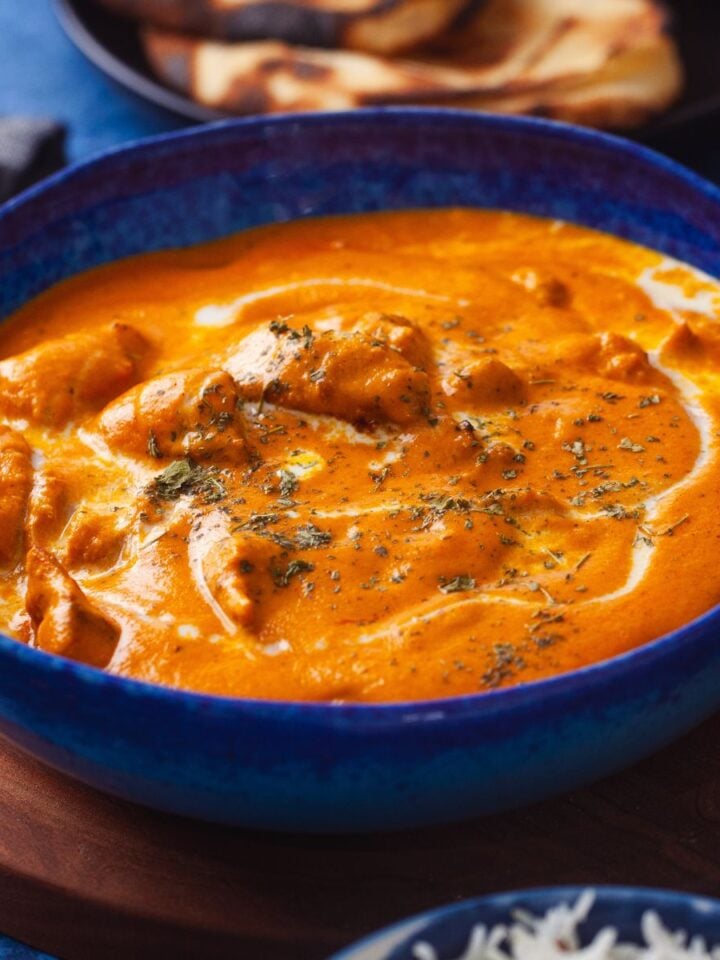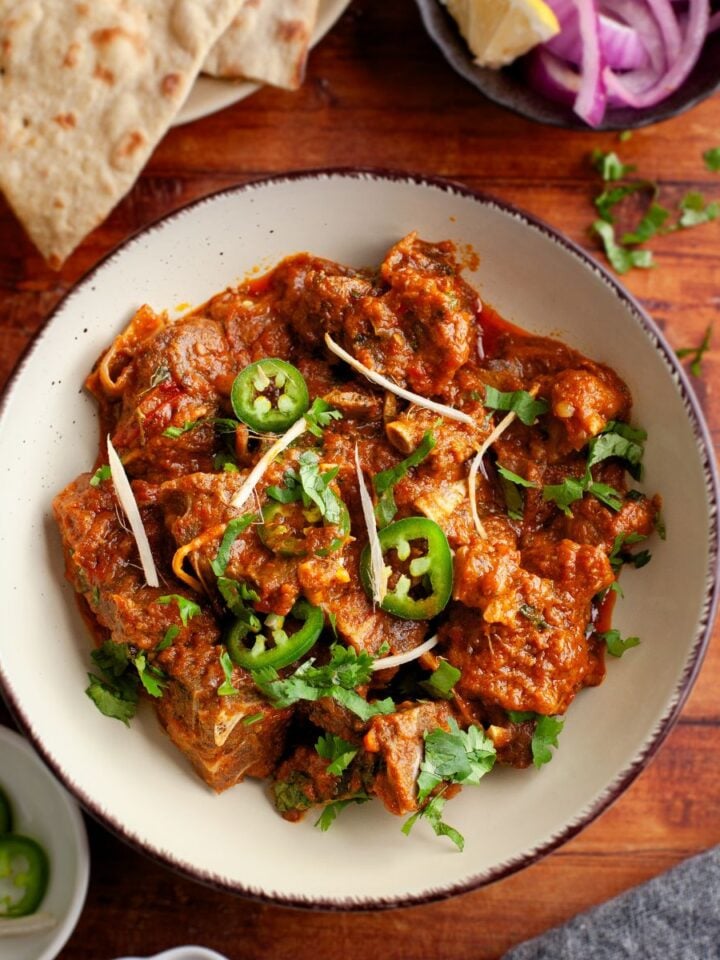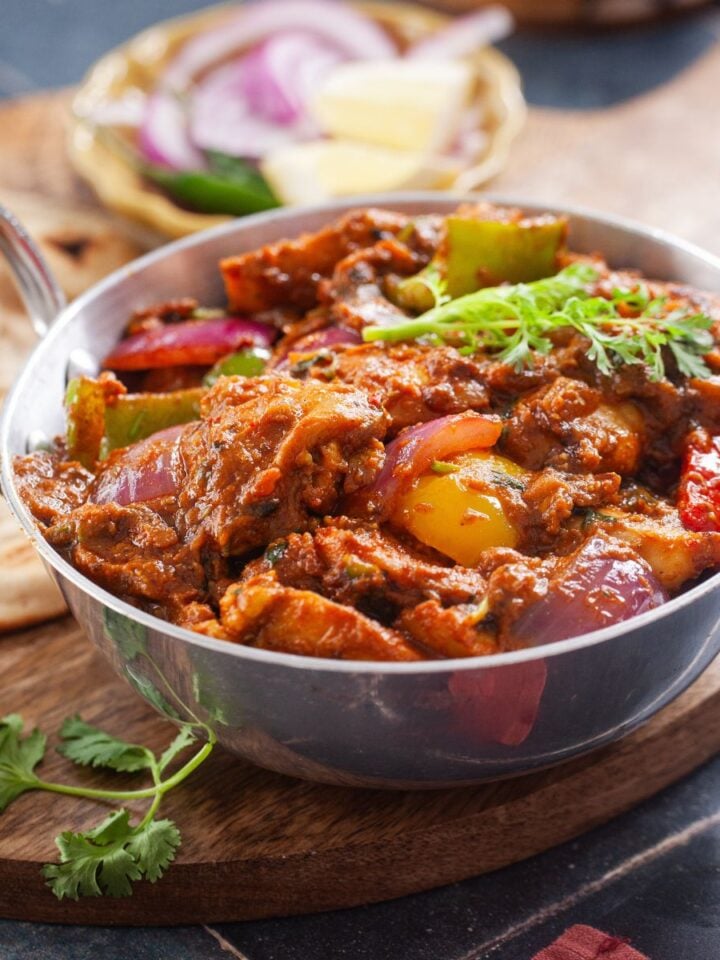Bhuna Gosht is a bold, braised meat dish that hails from North Indian and Pakistani kitchens. If you're in the mood to whip up a rich, no-fuss meat curry that leans on minimal ingredients but delivers maximum flavor, this recipe is for you. No marination, no tomatoes, no juggling multiple pots. It's a solid, one-pot wonder.
I use a pressure cooker (or use the Instant Pot). But if you’ve got time to spare and want to fill your kitchen with the slow-roasted aroma of bhuna spices clinging to tender meat, I’ve included stovetop instructions too.

Weekends were reserved for traditional meat dishes in our home. If you walked into my family kitchen on a Sunday afternoon, chances are you’d hear a steel spoon scraping the bottom of a pressure cooker. That unmistakable intense aroma of meat slow-roasting in its own masala meant only one thing - bhuna was in the making.
Bhuna Dishes
This isn’t your straightforward goat curry. First, I don't slow cook it. I grew up eating the pressure cooker version and continue to cook it same way. Then, it does take a bit more effort because it calls for bhunai, the slow, deliberate roasting of meat and spices until the masala is rich, concentrated, and clinging to the meat. We don’t rush it. We sear, we stir, and we let the flavors build, layer by layer.
In my family, we’re absolutely hooked on bhuna-style dishes. Whether it’s tender gosht or chicken bhuna masala, we all agree that nothing beats the intensity that comes from properly “bhuno-ing” the masala.
When you bhuno meat over high heat, you’re not just cooking, rather you’re coaxing out flavor. Instead of simmering in its own juices right away, the meat gets a chance to brown, the fat begins to render, and the oil separates from the spice paste. That’s what gives bhuna dishes their signature depth and unforgettable taste.
Bring On The Heat!
Are bhuna dishes spicy? They can be, especially if that’s how you like them. Bhuna dishes are known for their intense, concentrated flavor. But if you’re not big on heat, it’s easy to tone it down. Just go light on the red chilli powder and skip the green chillies. You’ll still get all the bold flavor, just without the fire.

Its all in the technique!
You’ll start by browning the onions first, then it's time to bhuno the meat with those onions. This part takes about 12 to 15 minutes. It needs a bit of patience and a fair amount of stirring, but trust me, it’s worth it.
Whether you pressure cook or use the stove top, pick a wide heavy-bottomed pot. It makes stirring easier, helps heat distribute evenly, and reduces the chance of burning at the bottom.
Once the meat is nicely seared, we pressure cook it until it’s tender, but not falling apart. It should hold its shape while still being soft. Then comes the magic touch. We will stir in some yogurt and our special, freshly ground garam masala.
After that, it’s back on the stove for one final round of bhunai. This last step ties everything together. The masala turns glossy, the oil begins to separate, and the aroma fills the kitchen. The oil separating from the meat, or what we call "taar," is a hallmark of traditional bhuna dishes. You’ll see exactly what I mean when you spot it in the pictures.
Ingredients

- Meat - Growing up, it used to be mutton, however, now I make bhuna gosht with lamb or goat meat because I don't get mutton here. Make sure that the meat is trimmed. I prefer to use bone in meat (like goat), however this recipe will work perfectly with boneless lamb shoulder or lamb leg. Beef stew meat will work too.
- Mustard Oil - For, authentic north indian dishes like these, I use pure mustard oil for that pungent smokiness. You could use ghee instead or avocado oil works just fine.
- Onions - Sliced. Browned onions are the key to this recipe and I prefer using red onions.
- Ginger & Garlic - I minced the garlic and julienne the ginger. You could use ginger in any form in this recipe- julienned or in a paste form. Store bought ginegr garlic paste is fine to use.
- Spices - There are a few ways in which whole & powdered spices are used to make bhuna gosht. Again nothing complicated! I like using degi mirch which is a red chili powder specifically for curries - it lends both the heat and color.
- Finishing Spice Blend - We are going to make a fresh and fragrant ground spice powder to finish bhuna gosht with black cardamom, cumin seeds, black peppercorns and cloves. Or use garam masala powder you have at home.
Note - Use green cardamom pods (seeds only) if you do not have black cardamom. Pease note that these two varieties of cardamom have a very different flavor profile and are exactly not a substitute for each other. Black cardamom is woody and smoky(perfect for meat) while green cardamom is sweet and balmy (used in deserts, pilafs or chicken, paneer dishes etc)
How To Cook Bhuna Gosht Masala
Browning the Onions
You can do the below steps on saute mode in an Instant Pot.
- Place a pressure cooker over low-medium heat and add mustard oil. Let it heat for about a minute and a half to remove the raw smell. If using regular oil or ghee, you can move on sooner. (image 1)
- Add the bay leaf and cinnamon stick. Sauté for about 30 seconds on low heat, stirring to avoid burning. (images 2 & 3)
- Next, add the sliced onions. Fry them on low to medium heat for 8 to 10 minutes until golden brown. This is the key step and controls color of final dish. Stir onions occasionally to prevent burning or uneven browning (Images 5 through 8)
Pro Tip - Browning onions is key to the taste of bhuna gosht, please don't rush this step. Avoid stirring too much else the onions will start steaming or breaking down instead of frying.


Bhuno the gosht & onions
- Add the goat meat, ginger juliennes (if using), and green chillies (if using). Stir to coat the meat with the onions. Bhuno the meat for 6 to 8 minutes, stirring often. The pink color will fade, and the meat will begin to brown. This is the start of the bhuna process. You may notice some moisture releasing and hear gentle sizzling. (images 9, 10, 11)
- Now add the garlic paste (or ginger-garlic paste), salt, and powdered spices. Stir well to coat the meat. Keep bhuno-ing. By the 12 to 14-minute mark, the meat will look much darker, and you’ll hear louder sizzling as more moisture releases. Continue frying until about 15 minutes. (images 12, 13, 14)



Pressure Cook Meat & Finish With Spices
- Add a small amount of water (about ⅓ to ½ cup). Just enough to keep the meat from drying out while pressure cooking. Meat will release its juices too. Bhuna gosht is meant to be dryish with a thick masala. (images 15, 16)
- Close the pressure cooker lid (image 17) or set your Instant Pot to pressure mode. Cook on low-medium heat for 3 to 5 whistles, or until the meat is about 85 to 90 percent done. Turn off the heat and let the pressure release naturally.
Pro Tip - During pressure cooking, we don't want to cook meat completely. Meat should be soft and tender yet not falling off the bone. This is because we will bhuno it more with yogurt in next steps.
- Make fresh garam masala for finishing. While the meat is pressure cooking, dry roast cumin seeds, black cardamom seeds, black peppercorns, and cloves in a small saucepan until they smell slightly smoky. Let them cool, then grind into a fine powder using a spice blender.
- Once the pressure cooker or Instant Pot lid is off, return it to the stove or switch to sauté mode on the IP. On low heat, add whisked yogurt to the meat and stir well. Bhuno the mixture for 6 to 8 minutes on low-medium heat. Cover the cooker (without sealing) and cook for another 7 to 8 minutes until the meat is tender, shiny, and the yogurt has cooked off. You’ll see oil separating at this stage. (images 18, 19)
- Sprinkle the fresh ground spice mix that we made and mix.(image 20) Bhuna gosht is ready!
- Garnish bhuna gosht with fresh chopped cilantro, mint or more ginger. Serve with hot flatbreads
Stove Top Bhuna Gosht
Follow steps 1 to 5 above in a heavy bottom wide pot(dutch oven is great).
For step 6, you will need ¾ to 1 cup water since stove top needs more liquid due to long time needed for cooking meat.
Follow the steps 8-9 as noted. Bhuno the meat after adding yogurt and cover again if needed until meat is cooked through.
Top Tip
- Don't skimp on oil - Bhunai needs enough oil to develop that deep, rich taste. The amount in the recipe is for leaner goat meat, so if you’re using lamb, you can use a bit less.


Bhuna Gosht
Equipment
- Pressure Cooker
Ingredients
- 5-6 mustard oil or any cooking oil you use at home
- 2 large bay leaves
- 2 inch cinnamon
- 2 large onions 300g sliced onions
- 2 lb (~964g) goat meat or lamb
- 1 tablespoon garlic minced
- 2-3 green chillies I use indian green chillies (hot), use Serrano, adjust to taste
- ½ teaspoon turmeric powder haldi
- 1.5 teaspoon red chilli powder (hot),adjust to taste
- ½ teaspoon kashmiri chilli powder (for color)
- 1 tablespoon coriander powder
- 1.5 teaspoon salt adjust to taste
- 2 tablespoon yogurt plain, whole milk, not too sour
Dry Roast And Grind (Fresh Garam Masala to finish)
- 1 large black cardamom(seeds only) moti elaichi
- 3 cloves laung
- 1 teaspoon cumin seeds jeera
- 12-15 black peppercorn kali mirch
Instructions
BROWN THE ONIONS
- You can do the below steps on saute mode in an Instant Pot.Place a pressure cooker on low medium flame on stove. Add mustard oil and let heat up for a minute and a half to do away its raw smell. If using oil or ghee, you don't need to wait that long.
- On low flame, add the bay leaf and cinnamon stick to the hot oil. Stir around using a cooking spoon for 30 seconds taking care not to burn.
- Add the sliced onions next. On low to medium flame, for the next 8-10 minutes we will fry the onions to golden brown. You can stir intermittently to make sure that onions are not burning or getting too dark or black.Please refer to images in the blog post to see different stages of browning onions. Pro Tip - Browning onions is key to the taste of bhuna gosht, please don't rush this step. Avoid stirring too much else the onions will start steaming or breaking down instead of frying.
BHUNO THE GOSHT & BROWNED ONIONS
- Add the goat meat, ginger juliennes and green chillies(if using). Stir around to mix the meat with the onions. For the next 6-8 minutes, bhuno(fry) the meat with browned onions. The meat will change color, its pink color will fade and slowly it will start browning. We have initiated the bhuna process. Depending on the quality and quantity of meat, you will start noticing some moisture and heat little sizzling sounds.
- Introduce the garlic paste (or ginger garlic), salt and powdered spices at this stage. Again stir around to coat the meat and continue to bhuno. You will notice that by 12 or 14 minutes, the meat will be much darker and the sizzling sounds will be loud. There will be liquid releasing from meat. Continue to bhuno the meat for up until 15 minutes. Tip - As the name "bhuna" suggests, the cooking process involves continuous stirring. Keep stirring the meat regularly to prevent it from sticking to the bottom of the pan and to develop deep flavors.
PRESSURE COOK MEAT & FINISH WITH SPICES
- Add little hot water (¼ to ½ cup) now. Don't add lot of water, just enough so that meat is not going to dry while pressure cooking. Bhuna gosht is commonly dryish with thick masala.
- Close the lid of the pressure cooker or turn IP to pressure mode. Cook on low medium flame for 3-5 whistles or until the meat is 85-90 percent cooked. Switch off the heat and let pressure come down. For IP, cook for high pressure for 6 minutes, let pressure release naturally for 7-8 minutes and then release manually. Pro Tip - During pressure cooking, we don't want to cook meat completely. Meat should be soft and tender but not be falling off the bone. This is because we will bhuno it more with yogurt in next steps.
- Make fresh garam masala for finishing - While the meat is pressure cooking, in a small sauce pan dry roast the cumin seeds, black cardamom seeds, black pepper corns and cloves. Dry roast until slightly smoky. Cool slightly and then grind into a powder using spice blender.
- Open the lid of pressure cooker or IP. Return cooker to stove or start saute mode for IP. On low flame, add the whisked yogurt to the meat and stir around. On low medium heat, bhuno the meat with yogurt for 6-8 minutes. Cover the cooker (without pressure) for 7-8 minutes or until the meat is tender, looks shiny and the yogurt has cooked off. You will notice oil separating from meat at this stage.
- Sprinkle the fresh ground spice mix that we made and mix.(image 20) Bhuna gosht is ready
- You could garnish bhuna gosht with fresh chopped cilantro, mint or more ginger.
Video
Notes
-
- Nutrition will vary based on portion sizes, quality of ingredients and choice of meat.
- Choosing Meat - I personally find the taste to be better when I use bone in meat like mutton or goat meat. However if you cannot find, boneless lamb will work too.
-
- Don't skimp on oil - Else the taste from bhunai will not come through. Plain and simple, you need oil to bhuno meat. That said, the oil quantity mentioned in the recipe card is for goat meat which tends to be leaner. If using lamb, use less oil.
-
- Use a Heavy Bottom Pressure Cooker- A heavy bottom cooking pot or cooker maintains even heat distribution and prevents the meat from sticking or burning during the bhunai. Though the instant pot gets the job done, I personally favor the pressure cooker or stove top pot for this dish.
-
- Bhunai and slow cooking - Even though we use pressure cooker to tenderize the meat, a lot of deep flavors develop in the meat while we bhuno it. This long and constant bhunai or frying makes this dish different from usually goat or lamb curry.
- Traditional Indian way to serve bhuna gosht is with tawa roti, roomali roti or paratha (indian bread cooked on griddle). However, we love it with doughy naan too. Add sliced onions, a fresh salad like kachumber, boondi raita and green chutney to brighten up your indian meal spread.
- You could definitely serve with steamed basmati rice.
- If you are making bhuna gosht with boneless meat like lamb, you could shred the lamb using fork and pile on top of dinner rolls.
- A tangy side such as a pickle - garlic achaar or tamarind chutney will also balance the taste of this dish






I'd Love to Hear from You!